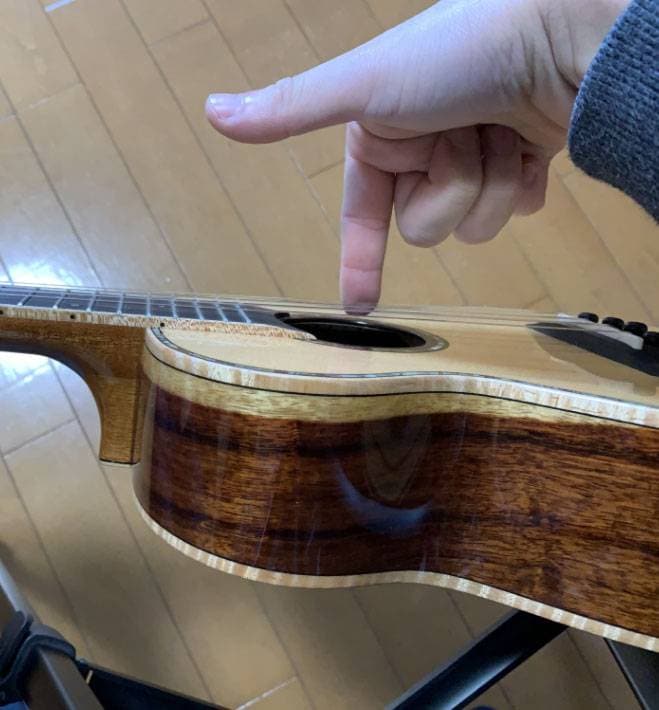Hello, it’s Conservario.
Once you’ve learned to play a few chords, it’s time to learn strumming.
Expanding your strumming techniques will greatly broaden your musical possibilities.
■ What is Strumming?
Strumming refers to the technique of using your right-hand thumb or index finger to strum across all the strings.
Even if you’re not familiar with the term ‘strumming’, if you can play chords, you’ve probably already done it.
When you strum downward toward the first string, it’s called a downstroke, and when you strum upward toward the fourth string, it’s called an upstroke.
As long as you produce sound, there’s no strict rule on how you should strum, but there are tips and key points to keep in mind.
Let’s master both downstrokes and upstrokes!
■ Downstroke
A downstroke is performed by strumming from the fourth string down to the first string using your right-hand thumb.
The key is to lightly touch the strings with your finger.
At first, you may find yourself striking the strings too deeply, as this movement might feel unnatural. If you describe this sound in words, it might be something like “bon-bin-bon-bin!”—each string ringing separately.
However, the goal is to make all the strings sound at the same time.
To achieve this, lightly touch the strings and aim for a smooth “sha-ran” sound where all the notes ring together.
One method I recommend is to imagine touching only the chipped part of a grain of rice with your thumb joint.
Look at the illustration.

If you observe a grain of rice, the upper right portion is often slightly chipped.
Think of your first thumb joint as that chipped part and let only that portion make contact with the strings.
You might wonder, “Is it really okay to touch the strings so lightly?”—but rest assured, it’s fine.
As long as you apply a moderate amount of force, even a light touch will produce a clear and beautiful sound.
Beginners often strike too deeply because it produces an immediate loud sound, making them feel like they’re playing correctly.
However, striking too deeply can introduce unwanted buzzing noises (a “beeing” sound) and make it difficult to strum quickly.
Aim for a light, smooth, and synchronized downstroke where all the strings resonate together.
■ Upstroke
As mentioned earlier, a downstroke is when you strum downward.
Conversely, strumming upward is called an upstroke.
Upstrokes are usually played with the index finger.
While it’s not impossible to use the thumb, it’s not very common.
Many players find upstrokes more challenging than downstrokes.
With a downstroke, you can rely on gravity to assist your movement, as you naturally press down with your thumb.
However, with an upstroke, you need to work against gravity, lifting your index finger back up.
Although upstrokes are considered difficult, mastering them will allow you to incorporate a variety of strumming techniques into your playing.
So keep practicing!
One important tip: Just like with downstrokes, avoid striking too deeply—keep your touch light.
Another key point for upstrokes is deciding whether to use the flesh of your finger or your nail.
If you strum with just your fingertip, the sound will be warm and mellow, similar to using your thumb. If you strum with your nail, the sound will be brighter, crisper, and more defined.
There’s no right or wrong choice.
It depends on your preference and the style of music you’re playing.
However, if you’re just starting to practice upstrokes, it’s best to choose one method and focus on it first.
If you alternate randomly, your upstrokes may become inconsistent and lack definition.
For the basic upstroke form, your index finger should be positioned so that the tip faces your body when you strum.
From a top-down view, it looks like this:

Your thumb should be positioned at nearly a right angle to your index finger.
Meanwhile, the other three fingers (middle, ring, and pinky) should be kept curled in, so they don’t accidentally hit the strings.
Some players let these three fingers dangle loosely while strumming, but adjusting your index finger’s depth or angle just to avoid them touching the strings is counterproductive.
This is the basic upstroke form, but it’s important to remember that this is not the only correct way to play.
If you analyze the playing styles of world-class ukulele players, you’ll notice that everyone has their own unique approach.
However, those unique styles come from years of practice and experience—if a beginner tries to imitate them right away, it often leads to frustration (speaking from experience...).
So, first master the fundamental form, and then gradually adjust it to suit your personal style!
■ Conclusion
In this article, I covered the techniques and form for both downstrokes and upstrokes.
To be honest, even now, I’m constantly fine-tuning my form and playing style, adjusting things like my angle and finger pressure.
I’m always experimenting to find ways to make strumming feel smoother and more natural.
Strumming is truly a deep and intricate technique, and in the end, the best way to play is different for everyone.
Everyone has different finger shapes, flexibility, and muscle strength.
Your strumming style will also depend on the type of music you want to play and which ukulele players you admire.
That’s why there’s no one-size-fits-all method.
The techniques I introduced here are just one example—a starting point.
However, I focused on methods that help beginners avoid bad habits, so if you’re just getting started and unsure how you want to play, feel free to practice these with confidence.
Thank you for reading until the end!
The “sound & person” column is made up of contributions from you.
For details about contributing, click here.











![[Enjoy the Ukulele Even More!] Listen to Skilled Musicians Play](/contents/uploads/thumbs/5/2022/3/20220328_5_17282_1.jpg)
![[Enjoy the Ukulele Even More!] Are You Practicing A Lot, But Still Can’t Get the Chords to Sound Good?](/contents/uploads/thumbs/5/2022/3/20220328_5_17277_1.jpg)
![[Enjoy the Ukulele Even More!] What to Do When Your Favorite Song Seems Too Difficult](/contents/uploads/thumbs/5/2022/3/20220328_5_17261_1.jpg)
![[Enjoy the Ukulele Even More!] Thinking About Playing a Sound](/contents/uploads/thumbs/5/2022/3/20220317_5_17099_1.jpg)
![[Enjoy the Ukulele Even More!] Hacks to Keep Your Strings Going Longer](/contents/uploads/thumbs/5/2022/3/20220317_5_17094_1.jpg)
![[Enjoy the Ukulele Even More!] For Those Who Feel Their Strumming Has Become Repetitive](/contents/uploads/thumbs/5/2022/2/20220228_5_16890_1.jpg)
 ウクレレのチューニング方法
ウクレレのチューニング方法
 ウクレレの各部名称
ウクレレの各部名称
 ウクレレの種類
ウクレレの種類
 ウクレレスタートガイド
ウクレレスタートガイド
 めちゃラク!ギター講座
めちゃラク!ギター講座
 ウクレレ初心者講座
ウクレレ初心者講座















